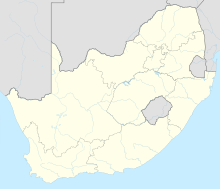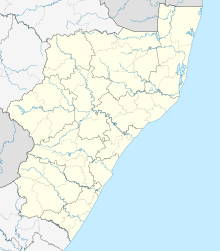| Battle of Rorke's Drift | |||||||
|---|---|---|---|---|---|---|---|
| Part of the Anglo-Zulu War | |||||||
 The Defence of Rorke's Drift, by Alphonse de Neuville (1880) | |||||||
| |||||||
| Belligerents | |||||||
|
| Zulu Kingdom | ||||||
| Commanders and leaders | |||||||
| Prince Dabulamanzi kaMpande | ||||||
| Strength | |||||||
|
3,000–4,000 Zulus:[4]
| ||||||
| Casualties and losses | |||||||
|
351 confirmed killed[7] About 500 wounded[8] | ||||||
Location in present-day South Africa | |||||||
The Battle of Rorke's Drift, also known as the Defence of Rorke's Drift, was an engagement in the Anglo-Zulu War. The successful British defence of the mission station of Rorke's Drift, under the command of Lieutenants John Chard of the Royal Engineers and Gonville Bromhead, of the 24th Regiment of Foot, began once a large contingent of Zulu warriors broke off from the main force during the final hour of the British defeat at the day-long Battle of Isandlwana on 22 January 1879. They traveled 6 miles (9.7 km) to attack Rorke's Drift later that day and continuing into the following day.
Just over 150 British and colonial troops defended the station against attacks by 3,000 to 4,000 Zulu warriors. The massive but piecemeal attacks by the Zulu on Rorke's Drift came very close to overwhelming the much smaller garrison, but were consistently repelled.[9] Eleven Victoria Crosses were awarded to individual defenders, along with a number of other decorations and honours.
- ^ Knight, Ian. Zulu: Isandlwana, Ulindi and Rorke's Drift, 1992, pp. 107–108.
- ^ Holme, Norman. The Noble 24th, Savannah Publications, ISBN 1-902366-04-2, 1999, p. 265–369, 383.
- ^ Whybra 2004, pp. 68–69.
- ^ Estimates vary: Colenso 1880, p. 305, gives 3,000; Knight 2003, p. 37, gives "in excess of 3,000"; Lock and Quantrill 2005, pp. 231–232 gives 3,000, p. 231; Morris 1998 gives over 4,000.
- ^ Knight 1996, p. 23.
- ^ Porter 1889, p. 33, "17 killed and 10 wounded" (including one killed by 'friendly fire' while fleeing the garrison at start of the battle)
- ^ Colenso 1880, p. 305
- ^ Lock and Quantrill 2005, excerpt from private journal of Lieutenant Colonel John North Crealock, Crealock states "351 dead were found and 500 wounded".
- ^ Knight 2003, p. 37.

